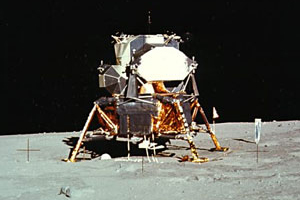A 110-meter-tall launcher, the most powerful ever built, launched the Apollo 11 spacecraft on its components to the moon, on a 4-day trip each way

First episode in the series to mark the event. This time we will deal with the structure of the Apollo 11 spacecraft.
The Apollo 11 spacecraft, whose height, including the launcher, was 110 meters, was then launched launch A in launch sequence 39 at the Kennedy Space Center, at 09:37 EST exactly 40 years ago today, on July 16, 1969. This was the first landing mission on the moon. The launch vehicle, AS-506, was the sixth in the Apollo Saturn 5 series. After two and a half hours of testing, the spacecraft was launched into the transition phase to lunar orbit.
The structure of the spaceship
Very few changes were made compared to Apollo 10. The main structural change was the lunar module. The addition is mainly intended for the component intended to store the experiments and tools used by the astronauts in their activities on the moon.
The Columbia command vehicle is actually divided into two parts - the command module, which is 3.63 meters long and has a cone shape that was in front (or on top at the time of launch). Equipped with armchairs, it serves as the crew's living area and control center, and is capable of storing all three astronauts. The command module is also used to return to Earth. The Service Module, a 6.88 m long cylinder at the rear of Columbia provided the primary propulsion and maneuverability for the spacecraft. Most of the consumed parts (oxygen, hydrogen, fuel) were stored in this module, which is separated from the command module before returning to Earth.
The lunar module - the eagle: this module also included two components - the landing phase and the take-off phase. The landing stage or lower part of the lunar module contained the engine that the astronauts used to land on the moon. This stage was a sort of aluminum cross with a height of 3.23 meters, which when standing on its legs' extensions reached its maximum diameter of 9.45 meters. The stage also contained equipment storage facilities and a ladder attached to one of the legs allowed crew members access to the surface.
When it was time to leave the surface, the landing stage served as a launch platform for the launch stage. The launch stage was based on a cylindrical aluminum structure with a diameter of 4.29 m and a height of 3.75 m. During the stay on the surface, the crew members lived inside it, and operated from this module. It was also used by the crew to return to orbit and the command and control module where Michael Collins stayed after the mission was completed.

12 תגובות
or those who lack rhythm 🙂
The Beatles were also incorrectly translated as beetles, although in a correct translation they should be called "the butchers".
OK. Has anyone died because of this?
I am sure that the people of Israel are not the only people who receive history a little differently because of translation problems.
That only these will be the world's troubles...
Shahar Hellman, you too have a mistake. hawk is a hawk and not an eagle.
To the doctor in quotation marks from 3. If you are a doctor then I am an astronaut. What's more, you must be an idiot.
Regarding the linguistic translation, there is absolutely no mistake and here is the explanation: Falcon in English is Falcon, Eagle is Hawk and Eagle is Eagle.
All this is without detailing the different classifications of ornithology.
Besides, interesting and beautiful articles are the articles regarding the Apollo project and the landing itself.
good day everybody.
Dawn
For 3,
You know they did land on the moon, there are photos of them moving and you can actually see them on camera
That it's not "produced-directed-filmed"…..
So don't try to root a bitter mistake in the foundation….
with gratitude…..
....
..........
If there is a mistake here, it is more related to the field of classifications and nuances in differences in ornithology.
In both Hebrew and English, the families of the falcon, the eagle, and the eagles are often confused.
Since this is an entrenched mistake, it is now difficult to go back after so many years (if I am not mistaken - from the beginning, that is, 40 years)
to 1. You are absolutely right, I'm afraid that quite a few of the Hebrew translators
(some of whom have ingrained this mistake) are simply unfit for their jobs.
The lunar module, eagle, means eagle in Hebrew, not eagle.